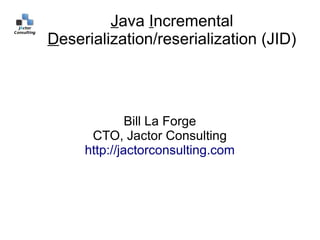
Incremental Java Deserialization/Reserialization
- 1. Java Incremental Deserialization/reserialization (JID) Bill La Forge CTO, Jactor Consulting http://jactorconsulting.com
- 2. The Problem ● Data is stored on disk as byte arrays, which may be quite large. ● These arrays must be deserialized before the data can be updated and then reserialized. ● There are various techniques for deserialization and reserialization but they are all quite slow as all the data is deserialized and then reserialized.
- 3. Incremental Deserialization and Reserialization JID Benchmark results for deserializing, updating and then reserializing large collections. Entries List Insertion Map Update 1,000 .014 ms .027 ms 10.000 .035 ms .056 ms 100,000 .24 ms .48 ms 1,000,000 2.9 ms 6.9 ms High performance is achieved by deserializing only the data that is needed and reserializing only the data that has been updated.
- 4. Types of Serialization ● Many applications use ● Hard-coded serialization reflection-based directly converst data serialization. from/to arrays of bytes. ● Reflection-based ● This is harder to serialization is the implement, but runs easiest to use, but also faster. the slowest. ● But mixing applicaiton ● There are three main logic with serialization types: native logic detracts from the serialization, XML-based clarity of the code. and Jason.
- 5. JID is Complex ● Every JID object must track the serialized data that has not been outdated and any data that has been deserialized, along with notifying its container when there is a change. ● Serializable data structures are trees of JID objects that are mostly instances of pre-defined classes. ● Application classes contain no serialization logic, but subclass a JID vector of homogenious JID types.
- 6. Factories ● Registered factory objects are needed to instantiate and initialize JID objects. ● Each registered facory object represents a different JID type and has a unique name. ● All factory objects are instances of subclasses of the JidFactory class. ● Factory objects used to instantiate application JID objects are instances of subclasses of AppJidFactory. ● These factory objects provide the type names of the registered factory objects needed to create the tuple elements of the application objects.
- 7. User Class public class User extends AppJid { private StringJid getNameJid() throws Exception { return (StringJid) _iGet(0);} private IntegerJid getAgeJid() throws Exception { return (IntegerJid) _iGet(1);} public String getName() throws Exception { return getNameJid().getValue();} public void setName(String name) throws Exception { getNameJid().setValue(name);} public int getAge() throws Exception { return getAgeJid().getValue();} public void setAge(int age) throws Exception { getAgeJid().setValue(age);} }
- 8. UserFactoryClass public class UserFactory extends AppJidFactory { final public static UserFactory fac = new UserFactory(); public UserFactory() { super("User", JidFactories.STRING_JID_TYPE, JidFactories.INTEGER_JID_TYPE); } protected User instantiateActor() throws Exception { return new User(); } }
- 9. User Test Environment public class Apps { public static void main(String[] args) throws Exception { JAFactory factory = new JAFactory(); (new JidFactories()).initialize(factory); factory.registerActorFactory(UserFactory.fac); . . . } }
- 10. Serializing RootJid rootJid0 = (RootJid) factory.newActor(JidFactories.ROOT_JID_TYPE); rootJid0.setValue("User"); User user0 = (User) rootJid0.getValue(); user0.setName("Fred"); user0.setAge(38); int serializedLength0 = rootJid0.getSerializedLength(); byte[] serializedData0 = new byte[serializedLength0]; rootJid0.save(serializedData0, 0);
- 11. Deserialization RootJid rootJid1 = (RootJid) factory.newActor(JidFactories.ROOT_JID_TYPE); rootJid1.load(serializedData0, 0, serializedLength0); User user1 = (User) rootJid1.getValue(); if (!"Fred".equals(user1.getName())) throw new Exception("unexpected result"); if (38 != user1.getAge()) throw new Exception("unexpected result");
- 12. JID Project JID Project Page: http://jactorconsulting.com/product/jid/ License: LGPL